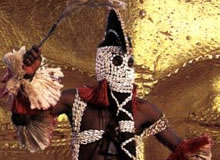Article/Document:
Can Tales of Sirius Be Taken Seriously?
Jay Ingram, The Toronto Star
original source | fair use notice
Summary: As winter rapidly approaches, sky watchers look forward to seeing Sirius, the brightest star visible in the Northern Hemisphere. Sirius is also the subject of one of the most enduring - and most farfetched - claims of extraterrestrial visits to Earth.
As winter rapidly approaches, sky watchers look forward to seeing Sirius, the brightest star visible in the Northern Hemisphere. Sirius is also the subject of one of the most enduring - and most farfetched - claims of extraterrestrial visits to Earth.
The story revolves around the Dogon people of west Africa. In the late 1940s, Dogon leaders laid out much of their tribal knowledge for two French anthropologists. Contained in that lore were intriguing references to Sirius - not just to the familiar, bright star, but to an invisible companion.
This second star was said by the Dogon to be composed of an extremely dense material ("all earthly beings combined cannot lift it") and to move in a 50-year orbit around Sirius. The anthropologists estimated that this knowledge had been part of the Dogon mythology for several centuries.
What struck westerners as remarkable about these beliefs is that it wasn't until 1862 that astronomer Alvan Clark discovered that Sirius did indeed have a small, barely visible companion star. The Dogon had apparently beaten Clark to the punch by several hundred years.
This sensational discovery was turned into an even more sensational book in 1976 called The Sirius Mystery. Author Robert Temple took the easy route to explaining the mystery by postulating that amphibious (!) aliens came to Earth 5,000 years ago and brought with them the secrets of the galaxy, including the existence of Sirius' companion.
The scientific community ridiculed Temple's explanation, and prominent astronomers, among them Carl Sagan and Ken Brecher, came up with the following explanation.
French missionaries had been active in the region where the Dogon lived since the 1920s. In Europe at that time real public excitement had been generated by Sirius.
Close examination of the light spectrum arriving at Earth from Sirius' tiny companion star showed that the light had escaped from an enormous gravitational field. This proved that the tiny star was indeed - as the Dogon had apparently maintained - extremely dense.
Brecher and Sagan argued that somehow the missionaries of the 1920s had conveyed that information to the Dogon, who in turn had incorporated it into their legends. Brecher suggested a scenario in which a Dogon tribesman asks a Jesuit for his myths, and the missionary replies, "See that star? It is actually two stars and the invisible star is the heaviest thing there is."
There are precedents for the incorporation of recent information into mythic formats. However, this explanation, while it preserves scientific sanity, has nothing like the romance of the original. And it hasn't gotten any better today.
Most of this theorizing and fantasizing I've described above took place in the 1970s. In the 1990s, the Dogon story lives on, although Robert Temple's aliens have been replaced by claims that the Dogon had incredibly powerful eyesight (beyond any known human capability) or that they learned about the stars from the ancient Egyptians, who had powerful telescopes (somehow overlooked by Egyptologists).
The counter-arguments these days are based on doubts about the very basis of the story. Some anthropologists today suggest that the original French researchers from the 1940s, not the Dogon, might have imprinted knowledge about Sirius on to stories gathered in interviews.
A Belgian named Walter van Beek, who has worked with the Dogon recently, found that the vast majority of these people know nothing about Sirius having an invisible companion, let alone anything about its mass or its orbital period.
He and his colleagues have noted the Dogon propensity for consensus, making it unlikely that the original story was one only a few elders might have known.
Perhaps the original anthropologists, aware of the existence of the massive, compact star, read too much into the Sirius legends related to them. Pick your favorite explanation.
You'll never be proven wrong.
---------------------------
Jay Ingram hosts the TV program @discovery.ca on the Discovery Channel.
Read more articles on this topic:






